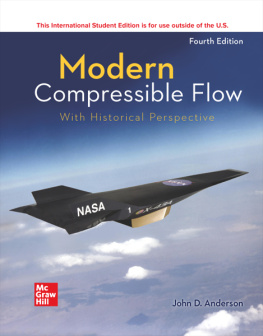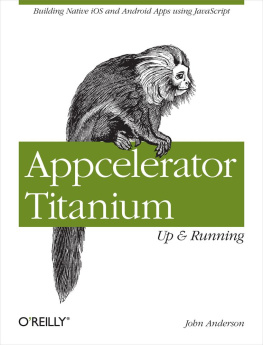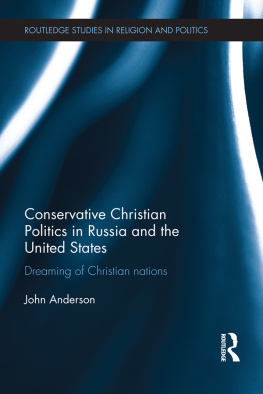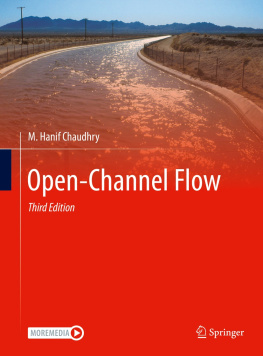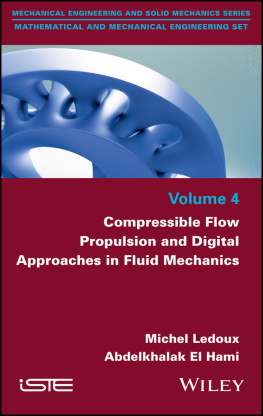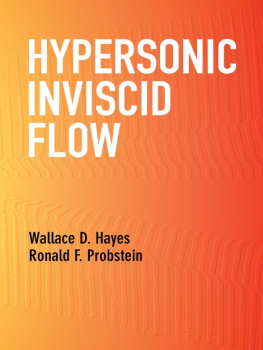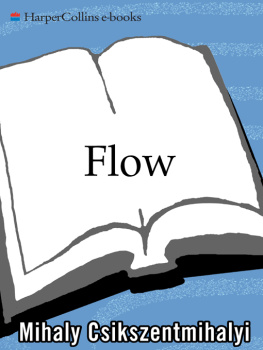
Page iv

MODERN COMPRESSIBLE FLOW
Published by McGraw-Hill Education, 2 Penn Plaza, New York, NY 10121. Copyright 2021 by McGraw-Hill Education. All rights reserved. Printed in the United States of America. No part of this publication may be reproduced or distributed in any form or by any means, or stored in a database or retrieval system, without the prior written consent of McGraw-Hill Education, including, but not limited to, in any network or other electronic storage or transmission, or broadcast for distance learning.
Some ancillaries, including electronic and print components, may not be available to customers outside the United States.
This book is printed on acid-free paper.
1 2 3 4 5 6 7 8 9 LCR 24 23 22 21 20 19
ISBN 978-1-260-57082-3
MHID 1-260-57082-7
Cover Image: NASA
All credits appearing on page or at the end of the book are considered to be an extension of the copyright page.
The Internet addresses listed in the text were accurate at the time of publication. The inclusion of a website does not indicate an endorsement by the authors or McGraw-Hill Education, and McGraw-Hill Education does not guarantee the accuracy of the information presented at these sites.
mheducation.com/highered
Page v
ABOUT THE AUTHOR
John D. Anderson, Jr., was born in Lancaster, Pennsylvania, on October 1, 1937. He attended the University of Florida, graduating in 1959 with High Honors and a Bachelor of Aeronautical Engineering Degree. From 1959 to 1962, he was a Lieutenant and Task Scientist at the Aerospace Research Laboratory at Wright-Patterson Air Force Base. From 1962 to 1966, he attended The Ohio State University under National Science Foundation and NASA Fellowships, graduating with a Ph.D. in Aeronautical and Astronautical Engineering. In 1966, he joined the U.S. Naval Ordnance Laboratory as Chief of the Hypersonic Group. In 1973, he became Chairman of the Department of Aerospace Engineering at the University of Maryland, and since 1980 has been a professor of Aerospace Engineering at Maryland. In 1982, he was designated a Distinguished Scholar/Teacher by the University. During 19861987, while on sabbatical from the university, Dr. Anderson occupied the Charles Lindbergh chair at the National Air and Space Museum of the Smithsonian Institution. He continued with the Air and Space Museum one day each week as its Special Assistant for Aerodynamics, doing research and writing on the history of aerodynamics. In addition to his position as professor of aerospace engineering, in 1993 he was made a full faculty member of the Committee for the History and Philosophy of Science and in 1996 an affiliate member of the History Department at the University of Maryland. In 1996 he became the Glenn L. Martin Distinguished Professor for Education in Aerospace Engineering. In 1999 he retired from the University of Maryland and was appointed Professor Emeritus. He is currently the Curator for Aerodynamics at the National Air and Space Museum, Smithsonian Institution, and Glenn L. Martin Institute Professor of Engineering at the University of Maryland.
Dr. Anderson has published twelve books: Gasdynamic Lasers: An Introduction, Academic Press (1976), and under McGraw-Hill, Introduction to Flight (1978, 1985, 1989, 2000, 2005, 2008, 2012, 2016), Modern Compressible Flow (1982, 1990, 2003, 2021); Fundamentals of Aerodynamics (1984, 1991, 2001, 2007, 2011, 2017); Hypersonic and High Temperature Gas Dynamics (1989); and under the American Institute of Aeronautics and Astronautics (2006, 2019), Computational Fluid Dynamics: The Basics with Applications (1995); A History of Aerodynamics and Its Impact on Flying Machines, Cambridge University Press (1997); Aircraft Performance and Design, McGraw-Hill (1999); The Airplane: AHistory of Its Technology, American Institute of Aeronautics and Astronautics (2002); Inventing Flight: The Wright Brothers and Their Predecessors, Johns Hopkins University Press (2004); X-15: The Worlds Fastest Rocket Plane and the Pilots Who Ushered in the Space Age (with Richard Passman), Zenith Press (2014); and The Grand Designers, Cambridge University Press (2018). He is the author of over 130 papers in radiative gasdynamics, Page vi re-entry aerothermodynamics, gasdynamic and chemical lasers, computational fluid dynamics, applied aerodynamics, hypersonic flow, and the history of aeronautics. Dr. Anderson is in Whos Who in America. He is a member of the National Academy of Engineering, an Honorary Fellow of the American Institute of Aeronautics and Astronautics (AIAA), and a Fellow of the Royal Aeronautical Society, London. He is also a Fellow of the Washington Academy of Sciences, and a member of Tau Beta Pi, Sigma Tau, Phi Kappa Phi, Phi Eta Sigma, the American Society for Engineering Education, the History of Science Society, and the Society for the History of Technology. In 1988, he was elected as Vice President of the AIAA for Education. In 1989, he was awarded the John Leland Atwood Award jointly by the American Society for Engineering Education and the American Institute of Aeronautics and Astronautics for the lasting influence of his recent contributions to aerospace engineering education. In 1995, he was awarded the AIAA Pendray Aerospace Literature Award for writing undergraduate and graduate textbooks in aerospace engineering which have received worldwide acclaim for their readability and clarity of presentation, including historical content. In 1996, he was elected Vice President of the AIAA for Publications. More recently, he was honored by the AIAA with its 2000 von Karman Lectureship in Astronautics and with its History Book Award for 2002 for AHistory of Aerodynamics. In 2002, he was awarded the position of Honorary Fellow of the AIAA, the Institutes highest award. In 2012, he received the inaugural Hypersonic Systems and Technology Award from the AIAA. In 2017, the National Aeronautic Association awarded him the Frank G. Brewer Trophy, awarded annually to an individual, a group of individuals, or an organization for significant contributions of enduring value to aerospace education in the United States. In 2018, he was awarded the Benjamin G. Lamme Meritorious Achievement Medal by the College of Engineering of The Ohio State University.
Dr. Anderson is active and known for his professional and educational activities both nationally and internationally. He has given more than 40 short courses to the major aerospace companies, the Air Force Academy, the government, and in Europe at Rolls-Royce in England and the von Karman Institute in Belgium. This includes a pioneering hypersonic aerodynamic course jointly sponsored by the AIAA and the University of Maryland and televised live nationally by satellite. In terms of the publishing world, in 1987 McGraw-Hill chose Dr. Anderson to be the senior consulting editor on the McGraw-Hill Series in Aeronautical and Astronautical Engineering. Recently, McGraw-Hill officially named the Anderson Series, with the statement: John D. Andersons textbooks in aeronautical and aerospace engineering have been a cornerstone of McGraw-Hills success for over two decades. McGraw-Hill proudly celebrates the impact that the Anderson Series has had on aerospace engineers and on students past and present.
Page vii
CONTENTS

Page xiii
PREFACE TO THE FOURTH EDITION
Next page
